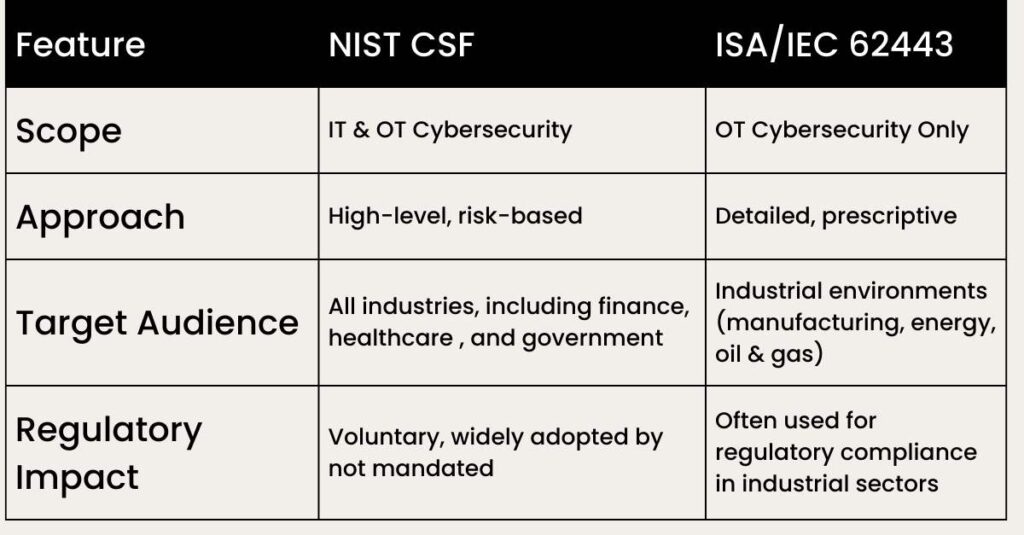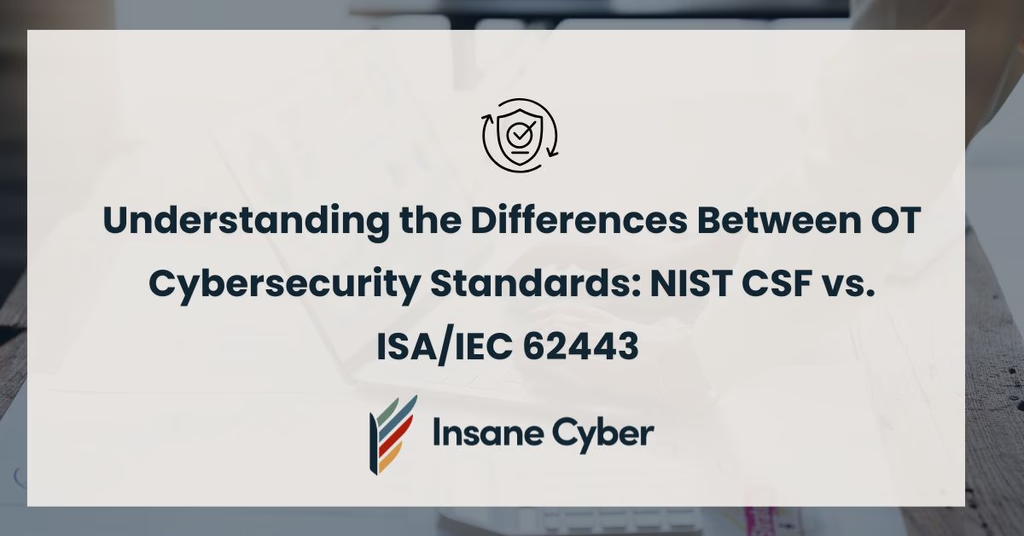Introduction
Operational Technology (OT) environments, including industrial control systems (ICS), supervisory control and data acquisition (SCADA) systems, and other critical infrastructure, face growing cybersecurity threats.
Cyberattacks on these systems can disrupt essential services, endanger public safety, and impact economic stability.
To address these threats, organizations rely on cybersecurity frameworks like the NIST Cybersecurity Framework (NIST CSF) and ISA/IEC 62443. While both frameworks aim to enhance OT security, they differ in scope, structure, and implementation. Understanding their differences can help you choose the right approach for your organization.
NIST Cybersecurity Framework (CSF): A Risk-Based Approach
What is NIST CSF?
Developed by the National Institute of Standards and Technology (NIST) in 2014, the NIST Cybersecurity Framework (CSF) provides a flexible, voluntary, and risk-based approach to cybersecurity. Originally designed for IT systems, it has been widely adopted for OT environments due to its adaptability.
Key Functions of NIST CSF
The framework is structured around five core functions:
-
Identify: Understand systems, assets, data, and risks.
-
Protect: Implement safeguards to mitigate risks.
-
Detect: Develop capabilities to identify cybersecurity events.
-
Respond: Create response strategies for security incidents.
-
Recover: Establish plans to restore normal operations after an attack.
Benefits of NIST CSF
-
Risk-Based: Prioritizes cybersecurity efforts based on risk assessment.
-
Flexible: Adaptable to various industries and organizational sizes.
-
Voluntary: Provides guidance rather than mandates.
-
Widely Adopted: Used across public and private sectors globally.
ISA/IEC 62443: A Specialized OT Security Standard
What is ISA/IEC 62443?
ISA/IEC 62443 is an international standard developed by the International Society of Automation (ISA) and the International Electrotechnical Commission (IEC). It provides detailed cybersecurity guidelines specifically for OT environments, making it a preferred choice in industrial sectors such as manufacturing, energy, and oil and gas.
Structure of ISA/IEC 62443
The standard is divided into four main groups:
-
General: Covers overarching cybersecurity concepts and terminology.
-
Policies and Procedures: Establishes security programs and best practices.
-
System Requirements: Defines security requirements for industrial automation and control systems (IACS).
-
Component Requirements: Specifies security controls for individual system components (e.g., software and hardware).
Benefits of ISA/IEC 62443
-
OT-Focused: Specifically designed for industrial control systems.
-
Comprehensive: Covers both organizational and technical security measures.
-
Prescriptive: Offers detailed, actionable cybersecurity guidelines.
-
Internationally Recognized: Adopted worldwide for OT security compliance.
NIST CSF vs. ISA/IEC 62443: Key Similarities
Despite their differences, these frameworks share common principles:
-
Risk Management Focus: Both emphasize risk identification, assessment, and mitigation.
-
Defense-in-Depth Strategy: Both advocate multiple layers of security to reduce attack risks.
-
Adaptability: Each framework can be tailored to different industries and risk profiles.
-
Lifecycle Security: Both stress continuous security monitoring and maintenance.

Choosing the Right Framework for Your Organization
When to Choose NIST CSF
-
You need a flexible, risk-based framework adaptable to both IT and OT environments.
-
You prioritize high-level guidance for overall cybersecurity governance.
-
You operate across multiple sectors and want a widely recognized framework.
When to Choose ISA/IEC 62443
-
You are focused on securing OT environments and industrial control systems.
-
You require detailed technical controls for industrial automation security.
-
You operate in industries where regulatory compliance with OT security standards is critical.
Can You Use Both Frameworks?
Yes! Many organizations benefit from adopting elements of both frameworks. A hybrid approach could involve:
-
Using NIST CSF for overall cybersecurity governance and risk management.
-
Applying ISA/IEC 62443 for in-depth OT security controls.
Conclusion
Cybersecurity in OT environments is critical, and choosing the right framework can significantly enhance your security posture. NIST CSF offers a high-level, flexible approach suitable for various industries, while ISA/IEC 62443 provides specialized, in-depth protections for OT environments.
By understanding their differences and potential synergies, you can implement a comprehensive cybersecurity strategy that meets your organization’s specific needs and regulatory requirements.
Next Steps
- Assess your organization’s cybersecurity needs.
- Map your security requirements to NIST CSF, ISA/IEC 62443, or both.
- Implement best practices to enhance your OT security.
Do you need expert guidance on implementing OT cybersecurity frameworks? Contact us today to safeguard your critical infrastructure!

